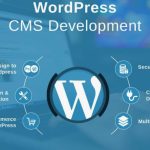Web design development follows a structured approach which enables perfectly designed platforms that function efficiently for users. A clear layout plan helps everyone build simple websites for business pages or personal blogs or e-commerce stores. Our guide will teach you how to develop a successful site through seven steps starting with goal understanding and finishing with site launch. Every step presents clear guidance because it makes website development accessible to people starting from scratch. Let’s get started.
What Is Meant By Web Design?
Web designers plan and construct websites that appear aesthetically pleasing while retaining functionality for diverse platforms. Web design demands the creation of layouts together with color choices and image integration and user interface optimization. Site structure has gained significant popularity in the USA as modern tools and technological advancements emerge. Businesses across the USA depend on web design to establish strategic sites which draw in customers. Web design using AI processed through automation makes the development process faster while simultaneously helping designers create distinctive and original websites that need less manual labor.
What Are The 7 Steps Of Developing A Website Design?
Building a website involves several critical steps, and here we will discuss the seven major steps essential to this process.
- Define Your Goals And Audience
The starting point begins with determining the purpose your site serves. Understand your audience completely so you can provide them with the experience they expect from your website. Such knowledge facilitates designers to generate layouts that serve their target audience’s requirements.
- Plan The Structure And Layout
The next step in the design process is to plan the structure. Designing a clear content structure begins with constructing a sitemap, followed by creating wireframes. The defined structure helps maintain conceptual links among all web pages. The website becomes easier to navigate because a detailed structure controls the path.
- Choose A Design Style
The selected colors along with fonts and layout aspects need to harmonize with your company’s brand image. Your portal presentation achieves professional quality through enforcing consistency. Your layout design should present both visual beauty and user convenience.
- Develop Content
Develop a mix of educational materials using images as well as informational text and relevant video content. Your content needs alignment with your website purpose. The success of visitors’ interest depends directly on content quality.
- Design And Build The Website
You can develop your site by using site creation platforms and design tools. AI-powered web structure tools allow developers to expedite this process in modern workflows. Check that the website design functions well across all types of devices.
- Test And Optimize
Test the website by fixing errors while checking links and testing functionality. Your testing should include different devices alongside different browser types because you need to validate performance across all platforms. Fix any problems before launching.
- Launch And Maintain
Once you’ve completed all of the necessary steps, launch your website. Regularly update it with new content and track its performance. Maintenance is vital for keeping your website secure and relevant.
Benefits Of Hiring The Professionals For Web Designing
The development life cycle of the portal is a difficult process; for a smooth website development process, it is better to seek help from a professional company. Webo 360 Solutions is a top U.S. company for site development and design. It helps small and large businesses. Following are the reasons to hire a firm for web and graphic designing.
Expertise In The Website Development Process
Website development professionals have the right skills to navigate all project stages through seamless, efficient operations.
Custom Web Design To Meet Your Needs
Web professionals develop websites according to business objectives which result in special designs both beautiful and appealing to specific target customers.
Optimized And User-Friendly Web Pages
Professional designers work to develop web pages that provide attractive layouts with simple navigation that works optimally across devices.
Time-Saving And Cost-Effective
Working with professionals lets you decrease project time and plummet expenses while enabling resource focus on your business needs.
SEO-Friendly And Successful Website
The team offers SEO services. They improve your site ranking and boost traffic. This helps your success.
Access To Advanced Tools And Technologies
Resourceful web design agencies embrace contemporary tools to produce websites that both operate at peak performance levels and provide modern features.
Ongoing Support And Maintenance
Web design companies deliver periodic system updates together with maintenance tasks which ensure your site functions properly and securely throughout its operational lifetime.
Conclusion
These seven development steps lead to a successful web structure process, which creates a website that achieves its intended goals. A successful website is both appealing and functional. Careful planning and design, plus a clear understanding of your web needs, lead to that. These procedures will help you create a unique, successful website. It will provide value to your audience, whether your site is for personal or professional use.
FAQs
Your website development has seven steps:
Understand your goals and target audience.
Create structure and layout plans.
Choose a layout style.
Write content.
Build the website.
Test for quality assurance.
Deploy and maintain
A website’s success depends on clear goals and a target audience. They help the site fulfill its purpose and meet users’ needs. Defining goals and knowing the audience is the foundation. It directs all design tasks that follow.
Online sites need sitemaps to visually display their structures which reveal page relations. Website navigation along with content organization become simpler due to this method.
All business sizes including small organizations can benefit from following this method. These design steps lead to a structured, professional design. It will help fulfill your goals.
This lets AI do with web design what it does best: create layouts, optimize designs, and produce content. It will result in faster, more efficient work.




